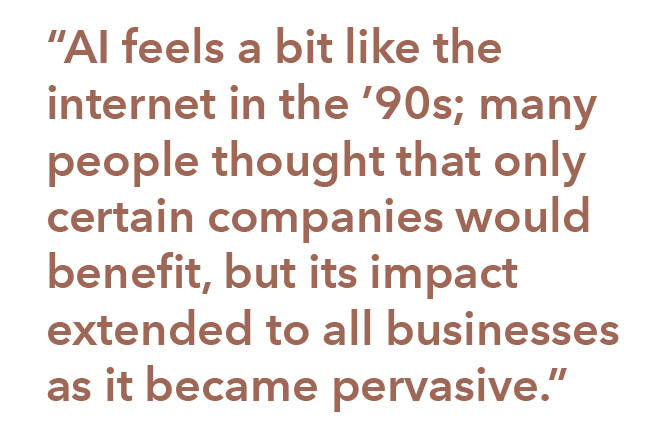International Equities
Philip Winston is a global equity portfolio manager at Capital Group. Earlier in his career, he was an equity analyst covering U.K. property and paper & packaging companies, as well as European property and media companies. We talked to Philip about the portfolio he manages, whose mix of sectors varies from the S&P 500. We also asked where he sees opportunity — and perhaps cause for caution — around the world.
Many investors have been focused on the U.S. because of the impressive returns provided by companies such as Meta and Microsoft. What’s your approach as you invest in other markets?
It’s true that the U.S. economy has been one of the strongest globally, especially since China’s economy has weakened somewhat in recent years. The U.S. stock markets have reflected that since the global financial crisis, but if you take a 30- or 40-year perspective, it has not always been like that. There have been periods where markets outside the U.S. were stronger, such as in the 2000s, where the MSCI EAFE had better returns than the S&P 500 for most of the decade.
That reflects different economies and different markets, each with its own strengths and biases. The drivers in one area might not be as important in another — companies are often subject to region-specific challenges or opportunities, and each market has its own mix of industries. If you think of social media platforms, the U.S. globally dominates. Outside of some interesting examples like Tencent in China, that industry is not readily replicable outside of the U.S. — and that means challenges in that industry would likely have a greater effect on U.S. markets.
In that sense, investing outside the U.S. offers pure diversification, but there’s more to it than that. The market there is obviously technology heavy with more than 25% of the S&P 500. Yet there’s no real U.S. alternative to a company like Netherlands-based ASML, which makes photolithography equipment. No other company can match its technology, making it a uniquely global or international stock choice.
And, of course, sometimes the better company to add to a portfolio is simply the one that’s not in the U.S. Staying with technology examples, Taiwan Semiconductor Manufacturing Co. has offered strong returns for years, often much better than many of its competitors. Other examples exist too, such as in aerospace and health care where European companies offer comparable or superior economics, often for lower valuations. Sometimes there aren’t even good comparisons. The handful of luxury goods companies in the U.S. lacks the cachet or breadth of European counterparts such as LVMH or Hermès.

Are there any particular industries you’ve been paying attention to lately?
Sure. There are a few places that have been very out of favor for the last year or so — pharmaceuticals, consumer staples and utilities come to mind. And while I invest in businesses, not industries, the market has discounted good and bad companies alike based on some broad concerns.
Pharmaceuticals have been battered as drug patents expired or neared expiration with few big replacements on the horizon. That’s an issue in an industry that’s all about innovation and new products, as demonstrated by the success of GLP-1 weight-loss drugs such as Wegovy and Ozempic. However, some of the companies, including many in Europe, have dealt with expiring patents better than their peers. I see a renewed and better disciplined focus on R&D, with a shift toward the most promising projects that have the best chance of being approved by regulators.
And in an example of one industry’s tailwinds being another’s headwinds, many investors cooled on consumer staples due to GLP-1 drugs, fearing that suppressed appetites would eventually take a bite out of snack revenue. However, I think that concern is overstated: Many consumer staples companies have diversified product lineups, and snacks are often just a small sliver of those businesses. The ones I’m interested in are often well diversified, with significant operations in, for example, coffee, health and wellness and pet food, amongst other areas. Many are also available now at reasonable valuations because of those outsize concerns.
In the case of utilities, what attracted me has been their burgeoning growth profile. Their outlook had been fairly muted, but the demands of computing power, AI data centers and electric vehicles have changed that. A much more efficient grid will likely be required to meet these needs, and I think the companies that can meet this challenge will be able to provide rising returns and growing dividends. One of Capital Group’s utilities analysts says we are entering “the golden age of grids.”
On the topic of technology — what are your thoughts on AI? It’s been such an important driver of U.S. technology returns.
Clearly, a small number of stocks are perceived to be massive beneficiaries of AI. Some of that is doubtless true, but I believe their share prices more than reflect that. AI feels a bit like the internet in the ’90s; many people thought that only certain companies would benefit from the world wide web, but its impact extended to all businesses as it became pervasive. Across the business spectrum, I think it is the companies that use and adopt AI that will benefit — and those that don’t adapt as well will probably be left behind.
It‘s clearly the topic du jour, and I’ve felt that the market may have been overly focused on it. The dot-com crash of 2000 is instructive: Many overhyped companies failed when the bubble burst, but the internet, the dot-com, it’s still here. It’s embedded in everything. Even earlier, in the 19th century, there was a big railway boom. Again, a lot of those companies would go on to crash, but railways are still here even today. Some investors might have been wrong about the specifics at the time, but both proved to be critical technologies.
